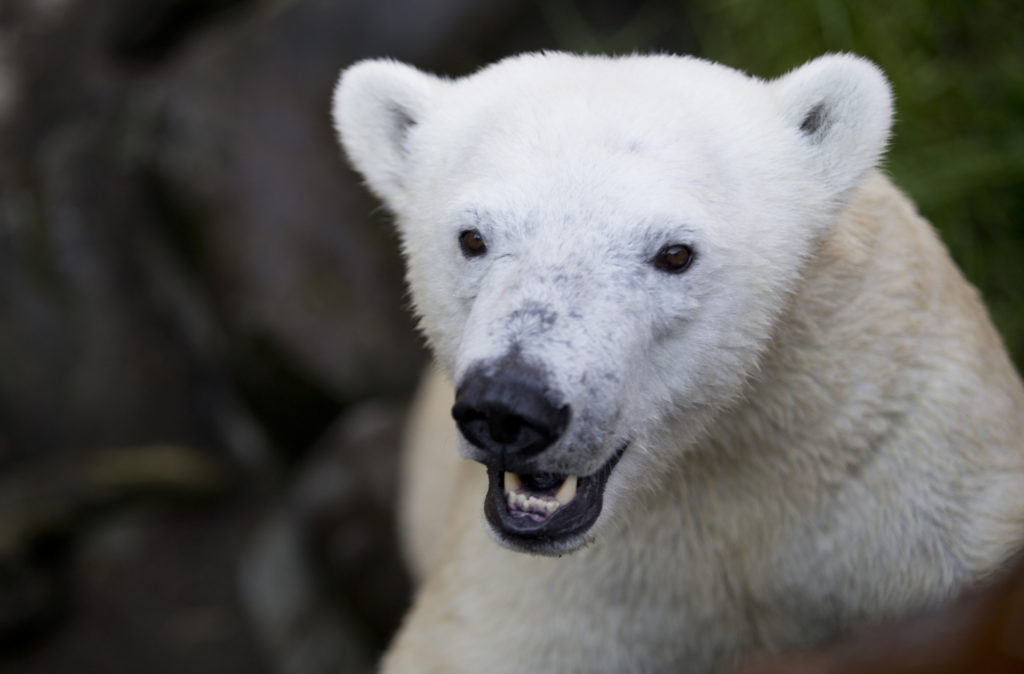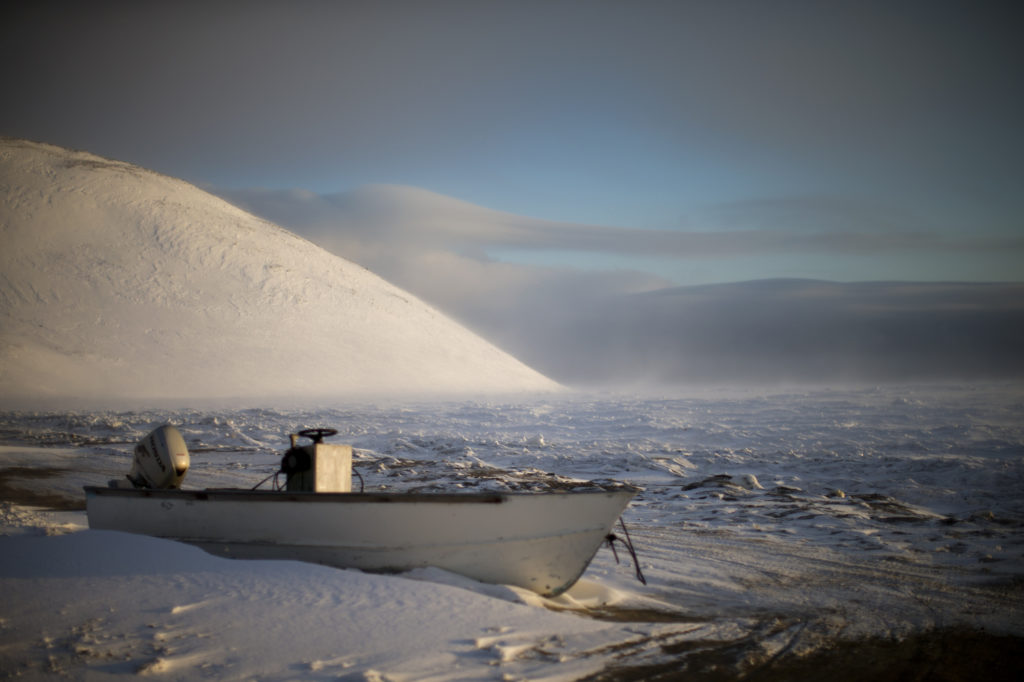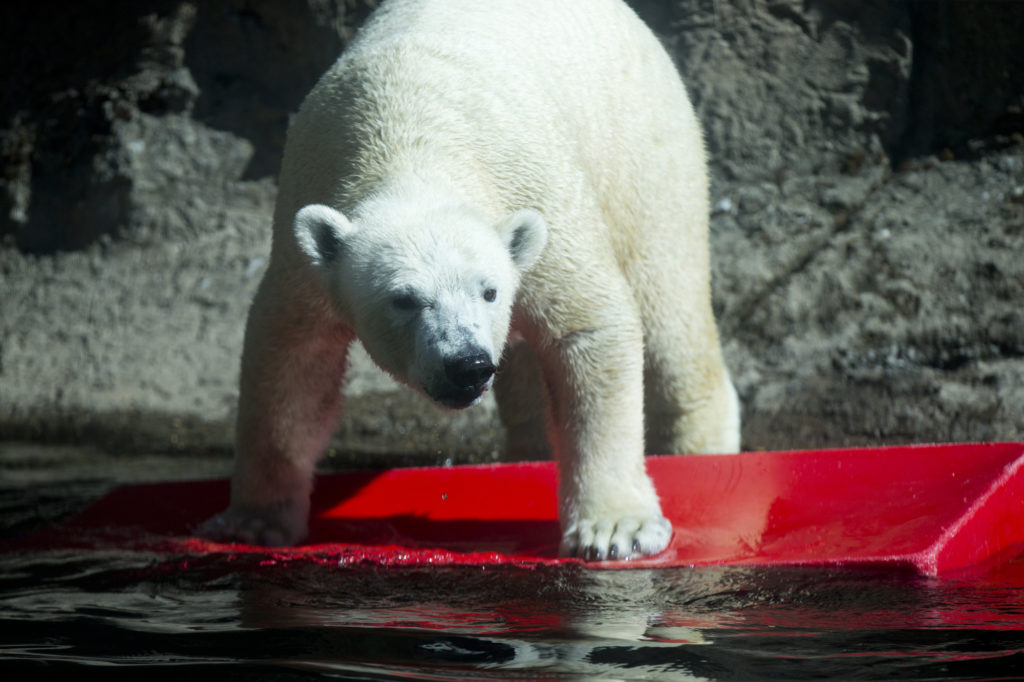The Loneliest Polar Bear | Chapter 1
Kale William’s 15,000-word narrative series on Nora the polar bear won the AAAS Kavli award in 2018. Williams is a science and environment reporter at The Oregonian.
In the den, the walls were white like ice. Light came from a single red bulb. The air smelled of cool concrete, of straw piled thick, and of a heavy, captive musk. Somewhere, tucked under her 600-pound mother, was Nora.
AAAS KAVLI SCIENCE JOURNALISM AWARD |
| The AAAS Kavli awards recognize distinguished science reporting by professional journalists. This story was honored with an award in the small newspaper category in 2018. |
She was the size of a squirrel, deaf and blind. Translucent fur barely covered her pink skin. Soft paws paddled against the straw, and her nose led her in one direction: toward her mother.
The bear cub woke only to nurse, which she did greedily and often, with a soft whir that sounded like a tiny outboard motor. She suckled even in her sleep, her curled, comically large tongue lapping at the air.
On the morning of her sixth day, her mother, Aurora, rose and stretched and ambled out of the den. Nora felt the chill return. As the minutes crept by, she searched for something familiar, casting her head side to side, unmoored from her mother’s gravity and heat. Her screech sounded like a baby dragon. When she got no answer, Nora began to wail.
***

In a trailer just outside the denning compound, zoo veterinarian Priya Bapodra squinted at a grainy, red video — a live feed from inside the polar bear den. Nora was a shifting shadow of pixels, barely discernible.
Zookeeper Devon Sabo took notes. For five days, Priya, Devon and a curator kept watch in rotating shifts. They craned their necks and pressed headsets to their ears.
Nora was the first newborn polar bear to live more than a few days at the Columbus Zoo and Aquarium since it opened in 1927. Her birth in a concrete den in central Ohio represented all the ways humans and polar bears were inextricably tangled — from the day nearly three decades before when an orphaned cub was pulled from an icy den in the Alaskan wilderness, to the political battle that appointed her species the sad-eyed symbol of climate change. She represented the damage humans had done to the Earth, and she offered the thinnest hope of setting things right.
To her species and to the zoo, she was priceless.
And so, at 8:55 a.m., as Aurora took one step away from Nora and then another, the women willed themselves to stay calm.
Aurora had left Nora alone for brief periods. But in the wild, a mother polar bear doesn’t leave the den, even to eat. Devon made a note in the log.
“Aurora gets up and goes into pool room.”
An alert went out over a text message thread to the rest of the animal care team.
Ten minutes passed.
Maternal instincts are innate in animals, but the young mom appeared conflicted.
Priya kept an eye on the clock. Twenty minutes now.
***
Alone in her den in November 2015, Nora was the only surviving polar bear cub born in the United States that year. A twin brother had lived less than two days and died with an empty stomach. Zookeepers believe he never tasted his mother’s milk.
Polar bears epitomize independence, savagery and power, but their newborn cubs are fragile and rare.
Adult bears mature late, have few litters and expend a great amount of time and energy raising their young. Every cub — wild or captive — shoulders a share of the burden of a species in peril.
No one knows how many wild polar bears exist because counting them is nearly impossible in the remotest regions of the planet. But only a few of the 19 subpopulations of polar bears are growing. At least three have been in steep decline in recent years.
In the Southern Beaufort Sea, along the northern coast of Alaska and Canada, researchers saw a 40 percent drop in polar bears in less than a decade.
In Canada’s western Hudson Bay, the bear population has dwindled at least 22 percent since the early 1980s. And in southern Hudson Bay, bears are thinner and dying younger.
The best guess puts the total count somewhere around 26,000 — about the population of Tualatin, a suburb of Portland.
To survive, polar bears need sea ice and sea ice is melting fast. NASA researchers using satellite imagery have seen the summer ice across the Arctic shrink 13 percent per decade on average since the 1980s.
Nora’s wild counterparts hunt seals from atop that ice. As the ice breaks earlier in the season, bears are forced to swim farther to find food and must fast on land for longer periods, disrupting their ability to breed. If trends continue, some experts say, two- thirds of polar bears could be extinct by 2050.
One of the few places on Earth where polar bear numbers are growing is in zoos. And at the Columbus Zoo, thousands of miles from those shrinking frozen seas, Nora was alone and in trouble.
***
Aurora had been gone for 30 minutes. She’d never left Nora for this long.
She wandered the rooms of the compound, seemingly deaf to the sounds of her daughter.
Inside the trailer, the tension was thick. Nora’s cries reminded the keepers of their own children, only louder and more urgent. As long as her vocals were strong, they were willing to wait.
The women watching had decades of experience hand-raising jungle cats, livestock and primates. The prospect was starting to hit them: Would they have to raise a polar bear?
At the one-hour mark, something had to be done. Devon went into the compound, carrying more straw to coax the wandering mom back to the den. She walked along the narrow path called “keeper’s alley,” beckoning.
“Aurora.”
The bear wouldn’t respond.
“Aurora.”
She sniffled and shuffled about.
“Aurora.”
Devon put the straw next to the room where Nora lay crying. Though she wasn’t ready to say it aloud, Devon couldn’t help but think that Aurora had given up on motherhood.
***

Twenty-seven years before Nora was born and 3,600 miles away, Eskimo hunter Gene Rex Agnaboogok grabbed his rifle, got on his snowmobile and headed onto the ice.
The morning had been disappointing and painfully cold.
Gene searched for three hours for a seal or fox or anything he could haul back to his village to eat. Then, just before 11 a.m., he found prints so large they could come from only one animal. In his village of Wales, Alaska, an adult polar bear could feed several families for weeks.
Gene followed the tracks onto the Bering Strait.
Close to shore, 4-foot waves of ice sat frozen in time — a rough, unmoving sea. Wind whipped the barren expanse, picking up snow and piling it in drifts.
Gene’s snowmobile bumped along over the ice until the desolate sea stretched flat for hundreds of yards. There, where the ice had been blown smooth, Gene lost the bear’s tracks. He throttled back the engine.
Now nearly a mile from shore, Gene hiked up the slope of an iceberg. It looked like a good place to take a coffee break and figure out his next move.
He pulled a Marlboro Light from his shirt pocket and poured coffee from a Thermos. His perch gave him a 360-degree view, but when he looked through binoculars, all he saw was emptiness and blowing snow. Hot coffee didn’t stand a chance in below- zero conditions, but he took one more sip. Gene flicked his spent cigarette and started walking back down the iceberg.
Halfway down, coffee in hand, he heard the ice crack. His weight felt suspended in air for a split second, and then he was falling.
He crashed waist-deep into one of the many cavities beneath the surface. As Gene struggled to gain his footing, he realized the ground below him was moving.
Gene had broken through the roof of a den, and he was standing on a polar bear.
Adrenaline flooded his nervous system and his legs scrambled against the ocean of fur. It felt like he was running on a waterbed.
Gene managed to plant the butt of his rifle in the snow. He spun, struggling to free himself.
He thrashed, heart hammering. As the bear moved underneath him, he leapt from the hole.
But behind him, the bear lunged. A claw pierced Gene’s right leg just above the knee.
Her nose hit the back of his leg and her lower jaw struck his heel. Had she turned her head sideways and latched onto his leg, the story might have ended there.
Instead, her head landed like a log, propelling him farther from the cave and onto the slope of the ice.
The bear circled behind the den, toward the top of the iceberg. Gene turned and saw her rearing on her haunches, tall and angry.
At a dead sprint, polar bears can cover nearly 30 feet per second. She was 15 feet away.
He aimed his rifle and squeezed the trigger. The gunpowder in his Remington .270 ignited and flung the lead slug in the direction of the bear. The bullet struck where her neck met her torso.
She crumpled, sliding down the iceberg back toward the den, using the last of her energy to draw her body as close as she could to the opening in the ice.
Breathless and exhausted, Gene thought he saw the bear move. He approached her carefully, then fired a second shot, just below the skull, to make sure she was dead.
As he stood over the bear, Gene saw movement inside the den and jumped back. He looked into the dark. Two small, white fluffs of fur peered back.
Baby polar bears, motherless on the ice.
It was at that moment that Gene noticed his pants were warm and wet. Assuming he had spilled coffee, he reached under his ski pants. His hand came up red, covered in blood leaking from the hole in his leg.
He was 20 miles from home, nearly a mile out on the sea ice and injured. The cubs would have to wait.
***
The next day, Gene’s father and nephew followed the snowmobile tracks back to the iceberg to salvage the hide and meat from the dead bear.
Gene’s dad stripped the fur from the animal, while his nephew approached the collapsed den. He saw the cubs, quiet and still.
Each was the size of a small raccoon, and they’d already grown sharp teeth. Gene’s nephew took off a glove and dangled it in front of the first bear as a distraction. When it lunged, he grabbed it by the scruff of its neck and put it in a cardboard box strapped to the back of the snowmobile.
He repeated the process with the second bear, lamenting the puncture marks the cubs were putting in his new gloves. With no room left in the box, he tucked the second bear into a backpack, its head poking out of an opening in the zipper.
Neither of those cubs would ever see the wild again. One was given the name Nanuq, and 27 years later, he would have a daughter, born in a zoo, named Nora.
***

Most polar bear cubs born in captivity live less than a month. Only about a third survive to adulthood. For hand-raised cubs, the odds are worse.
They can’t regulate their temperature. They succumb to disease and infection. They suffer from malnutrition and bone issues because their mother’s milk is impossible to replicate.
Zoos rely on a comprehensive birth plan, drafted long before the mother goes into labor. Aurora’s 23-page plan was kept in a binder in the denning compound. The keepers each had a copy on their phones.
The plan accounted for all conceivable scenarios, including pulling a cub from its mother.
“It will not be possible to return the cubs to the female when their condition improves or they have been stabilized, as she will not accept them,” the plan read.
At the two-hour mark, Devon went into the denning compound again. This time she brought fish.
“Aurora,” Devon called out.
“Aurora.”
On the text thread, Devon relayed what was happening. Soon, other keepers showed up to watch. Questions swirled in their heads. Could something have driven Aurora from the den? What else could they do to coax her back? How long should they wait?
Three hours had gone by, and now the keepers gave Aurora a deadline: one more hour. If Nora appeared to weaken, they would swoop in sooner.
None of them wanted to raise Nora themselves. Her odds would plummet the instant they plucked her from the den. But they didn’t want to stand by and watch her die, either. Left alone, her odds were zero.
They grabbed a plastic bin and lined it with heated water bottles and blankets. Without her mother’s warmth, Nora had to be getting cold.
At 12:43 p.m., almost four hours after Aurora left the den, Nora’s cries weakened ever so slightly and she looked sluggish.
It was time.
Devon went to the far side of the denning compound with a plate of smelt, one of Aurora’s favorite snacks. She grabbed a fish with a pair of tongs and called Aurora. She was distracting the bear so Aurora wouldn’t notice as the door slid shut behind her. Moving slowly, a curator quietly secured the door with a padlock. As it clicked into place, any remaining bond between Aurora and her daughter was severed.
Priya unlocked a second door and entered the den, crouching to avoid the low ceiling. It was just a couple of steps to Nora. Priya knelt, pushed aside some straw and scooped her up.
Nora fought, wriggling against the intrusion, the strange smells, the alien touch.
She was just a pound and a half, and dangerously cold. Intervening was a radical move, and it came after decades of human meddling in her world. There was wildness in Nora, who bleated and squirmed. But the untamed expanse of ice that her father had once known was shifting, melting, fading away. There was no perfect home for her, not anymore.
Nora and the fate of her species were in human hands now.
You may view the rest of this series at The Oregonian.

